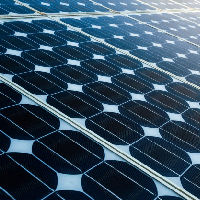
Parallel Connected Solar Panels
How Parallel Connected Solar Panels Produce More Current
![]() Understanding how parallel connected solar panels are able to provide more current output is important as the DC current-voltage (I-V) characteristics of a photovoltaic solar panel is one of its main operating parameters. The DC current output of a solar panel, (or cell) depends greatly on its surface area, efficiency, and the amount of irradiance (sunlight) falling onto its surface.
Understanding how parallel connected solar panels are able to provide more current output is important as the DC current-voltage (I-V) characteristics of a photovoltaic solar panel is one of its main operating parameters. The DC current output of a solar panel, (or cell) depends greatly on its surface area, efficiency, and the amount of irradiance (sunlight) falling onto its surface.
As we have seen throughout theses alternative energy tutorials, photovoltaic solar panels are semiconductor devices that covert sunlight into electrical DC energy. Connecting PV panels together in parallel increases current and therefore power output, as electrical power in watts equals “volts times amperes” (P = V x I). Note that photovoltaic panels DO NOT produce or generate alternating current, (AC) that you find in your homes. That is, alternating current solar panels dos not exist.
Photovoltaic cells produce their power output at about 0.5 to 0.6 volts DC, with current being directly proportional to the cell’s area and irradiance. But it is the resistance of the connected load which ultimately determines the amount of amperage supplied by a panel, or pv cell.
We measure electric current in amperes, commonly called “amps”. Amps is the measurement of current that is effectively the rate of electrical charge flowing past a fixed point within a circuit. Thus, the more charge flowing past a point the greater the value of the current.
Irradiance is the amount of solar radiation received at a given area on earth so as the current demand from a cell increases, brighter sunlight (given in watts per metre squared, W/m2) is required to produce the full output power, but there is a maximum limit to the amount of current a solar cell can generate no matter how bright and intense the irradiance of the sunlight.
While individual solar cells can be interconnected together within a single PV panel, solar photovoltaic panels can themselves be connected together in parallel strings to form an array of interconnected panels increasing the total available power output for a particular solar application compared to a single panel.
If there is no-load connected to a solar panels terminals, then the panel will generate no current as there is no electrical circuit for it to flow around. But if the terminals are shorted together, the current demand is very high so the photovoltaic panel generates its maximum output current, commonly called its short-circuit current, ISC from the available light.
When connecting solar panels together in parallel, the total voltage output remains the same as it would for a single panel, but the output current becomes the sum of the amperage of each panel. Thus the effect of parallel wiring is that the voltage stays the same while the amperage adds up.
Parallel Connected Solar Panels
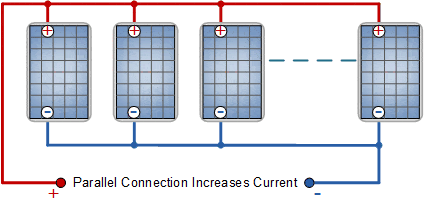
How to Connect Solar Panels in Parallel
Photovoltaic solar panels generate a current when exposed to sunlight (irradiance) and we can increase the current output of an array by connecting the pv panels in parallel. That is connecting solar panels in parallel increases the available current of the system, so two identical panels connected in parallel will produce double the current as compared to just one single panel. But while the currents add up, the panel voltage stays the same.
When PV panels are wired electrically in parallel, the positive (+) terminals of all the panels are connected together (positive to positive), and all the negative (-) terminals are connected together (negative to negative). When all the PV panels are wired together in parallel, you should be left with one single positive terminal, or wire, and one single negative terminal, or wire to attach to your regulator and batteries. Note that series strings of PV panels can also be connected in parallel (multi-strings) to increase current and therefore power output.
Parallel Connected Solar Panels of the Same Type
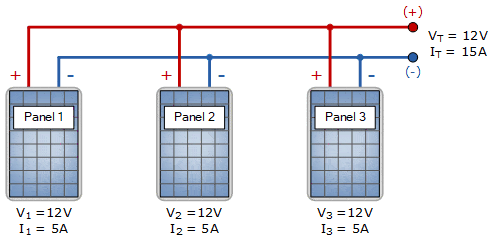
In this scenario, all the solar PV panels are of the same type and power rating. The total current output becomes the sum of the current rating of each individual panel but the parallel connected voltage is equal to the panel voltage as shown.

Using the same three 12 volt, 5.0 ampere pv panels from above, we can see that they are connected together in a parallel. The combined connection produces a total of 15 amperes (5 + 5 + 5) at 12 volts DC, giving combined wattage of 180 watts (volts x amps), compared to the 60 watts of just one single panel.
So if the array consisted of “n” number of solar pv panels with exactly the same electrical characteristics, then the total current output would be I1 times “n” (I*n) amperes with the output voltage being equal to V1. Thus the total power output of the combination will be equal to V*I*n watts.
Now let’s look at connecting solar panels in parallel with different nominal current ratings but with identical voltage ratings.
Parallel Connected Solar Panels of Different Currents
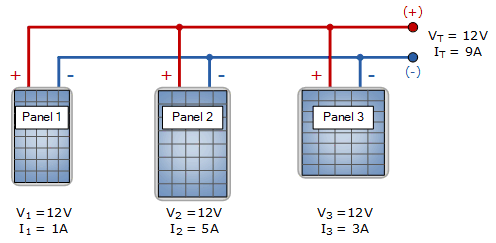
In this method all the solar panels are of different types and therefore power rating but have a common voltage rating. That is the same nominal voltage is available from all the panels. We have seen previously that for parallel connected panels their currents add together, so no real problem there, just as long as the panel voltages are the same and the output voltage remains constant.
This parallel combination produces 12 volts DC at 9.0 amperes, generating a maximum of 108 watts. Again the total output current, IT will be the sum of the individual panels which will depend on the number of connected panels. As before the output voltage remains the same at 12 volts.

Note that while manufacture’s will state a maximum or peak wattage (40W, 100W, 150W, 240W, etc.) for a panel, abbreviated WP (watts-peak), this wattage value is where the nominal voltage and current ratings of the panel apply on the I-V characteristics curve.
For example, 12 volts x 5 amps = 60 watts. However, the short-circuit current, ISC is the panel current measured in full-sun (1000 W/m2) when the positive and negative terminals are shorted together. Thus ISC is the maximum current that a panel is capable of producing when the voltage across it is zero (when the solar panel is short circuited).
A panels short-circuit current depends on a number of factors such as the area of the solar panel, the irradiance, temperature, etc. But a panels ISC can be as much as 10% higher than the panels nominal current rating (IMP) which may not sound very much but could result in excessive over currents through cables for large parallel combinations of panels.
Then while our simple example has a nominal current of 9 amperes at maximum power, it could potentially be higher at 9.9 amperes (9 x 1.1). Thus, it is this higher current value which needs to be considered when installing cabling between parallel connected panels and DC loads, etc.
It is also possible to have series connected solar panels called “strings”, and then connect the individual series strings together in parallel branches.
Wiring PV panels in series and then the series-strings in parallel increase both the maximum voltage and the maximum current rating of the array. The advantage here is that this series-parallel combination of panels allows the array to be more compatible with inverters or charge controllers typically designed to accept higher voltage and current inputs, for example, 200 volts at 20 amperes.
Of course this assumes the panels have identical electrical characteristics and that there is the same number of PV panels per string, so that the amperage of the series-strings add up while the voltage of each string remains the same and constant.
But what if the solar panels are non-identical and have different nominal voltages, how will this affect the output power. Let us look at connecting solar panels in parallel with different nominal voltage values but the same current ratings.
Solar Panels in Parallel of Different Voltages
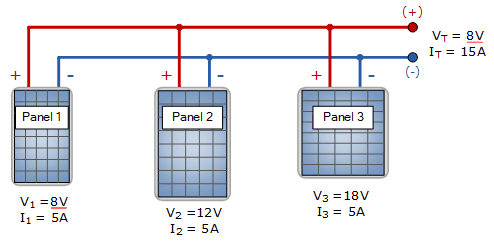
Here all the solar panels are of different voltage ratings but have the same nominal current. The individual panel currents will still add together as before whether their strengths are the same or different, but this time the output voltage will be limited to the value of the lowest panel in the parallel combination, in this case 8 volts due to this voltage mismatch. Then in this simple example the parallel circuit will produce about 8 volts at 15 amperes.
However, in reality the overall output voltage of the parallel combination will be somewhere between the lowest panel voltage and a mean (average) value determined by the rest of the panels in the array. At low output voltage levels this mismatch may not be a problem, but as the solar irradiance increases towards or beyond full sun (1000 W/m2) the mismatch in the current-voltage (I-V) characteristics of each photovoltaic panel can cause significant power loss in a large array, so is best to be avoided.
After all you would not connect a 6 volt battery in parallel with a 12 volt battery and expect the combination to produce a perfect 12 volt output, or the 6 volt battery not to overheat, which it will. But for this simple tutorial we will assume it to be equal to the lowest panel voltage value.
Now let us look at connecting solar panels in parallel with different wattage ratings as this is the most common scenario.
Parallel Connected Solar Panels of Different Wattages
Here let us assume we have four solar pv panels, two are rated at 80 watts, 12 volts, and two are rated at 100 watts, 12 volts giving a theoretical total of 360 (80+80+100+100) watts at 12 volts. The question here is how to connect the solar panels in parallel. We could connect all four together in a parallel combination (1 x 4), or connect the two 80 watt panels in series and the two 100 watt panels in series with the two series strings in parallel, (2 x 2). There are different wiring possibilities.
However, looking at the datasheet of the photovoltaic panels we can see that the maximum power point voltage (VMP) and current (IMP) values are different between the 80 watt panels and the 100 watt panels. Thus the panels are not the same as:
The characteristics given for the 80 watt panels are:
PMP = 80 watts, VMP = 20.9 volts, IMP = 3.85 amperes
and the characteristics given for the 100 watt panels are:
PMP = 100 watts, VMP = 17.9 volts, IMP = 5.72 amperes
Clearly, although all four panels are rated at 12 volts, their current-voltage (I-V) characteristics are very different, so connecting them in parallel is not easy.
We have stated above that it is not advisable to connect solar panels in parallel with different voltage values, and while it is not perfect, connecting solar panels together with different nominal current ratings is slightly better than a voltage mismatch but it will be the panel with the lowest current rating which will decide the total power output.
So if we connect an 80 watt panel in series with a 100 watt panel to form one series string, do the same for the second series string, and then connect these two series strings together in parallel, this will give us the following combination:
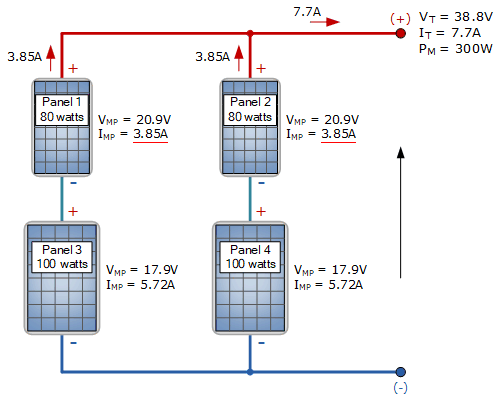
Then as the parallel current is restricted by the lowest value panel, (panels 1 and 2), the total power output is calculated at 300 watts (P = V x I) and not the expected 360 watts, a reduction of nearly 17%. Then clearly when connecting solar panels in parallel it is more efficient to use pv panels of the same characteristics.
Parallel Connected Solar Panels Summary
We have seen here that parallel connected solar panels increase the available current. Thus “parallel connected solar panels are about current” as IT = I1 + I2 + I3, etc. so parallel wiring = more current.
How many solar pv panels you connect together in parallel depends on what amount of current you are aiming for or the number of solar panels you have available, but you MUST take into consideration the possible short-circuit current, ISC value of all the panels (modules).
While the current may increase, the voltage will equal to the panel voltages. If all the solar panels have the same electrical characteristics then the parallel combination will produce 100% of the available power at full sun (1000 W/m2).
If the parallel connected pv panels are of different wattages and ratings, then both the voltage and current are limited to the lowest values, reducing the efficiency of the parallel connected array even at maximum irradiance. Voltage mismatch must be avoided in parallel connections.
Thus panels of different types, monocrystalline or polycrystalline or with different WMP wattage values, for example 40 watt together with 50 watt should not be connected together in parallel as it would not produce the expected 90 watts (40 + 50), thereby wasting your money on the larger 50 watt panel.
Solar photovoltaic panels are a great way of producing electrical power for free and are available in a range of wattage values from less than 10 watts to over 200 watts to suit many solar applications. But in order to achieve the highest efficiency and return on your investment from your parallel connected array, positioning, sun angle and the amount of irradinance are just as important as using the same make and model of solar panel. A little thought will help save you a lot of money.
For more information about parallel connected solar panels, or to obtain more information about the different types of solar panels available you can use to connect in parallel, or to explore the advantages and disadvantages of using solar power in your home, then Click Here to order your copy from Amazon today and learn more about designing, wiring and installing off-grid parallel connected solar panels to provide a renewable photovoltaic solar electric systems for your home.
Some high quality solar panels you may be interested in which can be connected together and used in solar arrays.











Two identical panels in parallel with opposite shading patterns, 1 points East 1 points West. Am I getting the best of use or the worst of use? Will they be better in series?
For maximum efficiency the ideal solar panel direction is facing south directly at the sun. Orienting panels away from the south immediately makes them less efficient. East facing solar panels will see the colder early morning sun, but possible cloudy skies. While panels facing west will generate energy when the afternoon/evening electricity prices are at their highest rates
But serial connection voltage and current values changes.
Indeed they do. Series Connected Solar Panels
I have a device I use outside that can work with an input voltage between 12 – 24vdc +-10%, I want to run it from a battery pack, and I want to charge that battery pack with solar power. I live in the north where the sunshine is limited and was wondering what is the best, most efficient way to charge the battery pack and what is the best battery connection to use?
My thought was to use 2- 12v batteries in series to make 24v and solar panels connected in series also to provide 24v to charge the battery pack. Is this best to rapidly charge my system with my limited sun exposure?
Thanks in advance.
Storage batteries can be recharged in a variety of ways with an alternative energy charging system using solar panels being the most popular. Connecting two 12 volt batteries in series would indeed give you your 24 volt supply to power your device. DC battery charging efficiency is usually between 85% and 95% for normal lead-acid batteries so you would need one or more series combination PV panel(s) producing 36 or more VMP volts to charge your batteries.
Charging current, and therefore number of series-parallel panels would depend on the rate (of charge or discharge) being equal to the battery banks capacity in ampere-hours divided by the time in hours it takes to cycle the series batteries. Note that your batteries should be completely charged each time they are cycled to prolong battery life.
Also, it is not adviseable to connect solar panels directly to a battery. A charge controller connected between the solar panels and the batteries keep the batteries charged at peak without overcharging and also prevents the batteries from discharging back through the panels at night.
This is really a good site for learning solar system and science as a whole lot’s of thanks
I have 6 x 315 panel’s identical. Voltage of each panel is 39v and amps around 9.5. I want to connect them to an off grid charger inverter with import parameters of 80volts and 60 amps.
Clearly, with an inverter limit of 80volts and 60 amps, you can connect your 6 panels as 2 series, 3 parallel (2S3P) to give you: 78 volts, 28.5 amperes at full sun. It’s basic math’s
what you have to do,isthat youhavetoconnettheparallelfirst
RV application – two identical solar panels wired in parallel. One oriented flat on the roof, the other on the
ground adjusted for maximum exposure. How will that affect total output?
If both panels are orientated towards full sun, then the output will be double the wattage of one single panel, as you state that they are two identical solar panels
you will receive the most energy from the panel from grn. panel and less from roof panel except when/if the sun hit the roof panel at the proper angle to draw the max energy then the panels will be equal for that bit of time, then when that bit of exposure is gone your just going to return to a smaller charge.
i we liketolessen more abarit
Thanks for the information. can i connect a 100 watt and 120 watt panel in parallel to charge a 12 volt battery
If both panels are rated at 12 volts and have very similar Vmp ratings then yes. The total full sun wattage would be 220 watts, at 18 amperes (12V panels)
I have three panels, two of them are 200watts /18v and a 300watts 31.8 v I want to know if it’s possible to connect them in parallel for a 60Ah controller to a 24v system
You could connect the two 12V 200W panels in series, and then connect the series combination in parallel with the 24V 300W panel
yes,But both panels will only draw from the weakest panel.the 100 wt.one, why ? i don’t know.